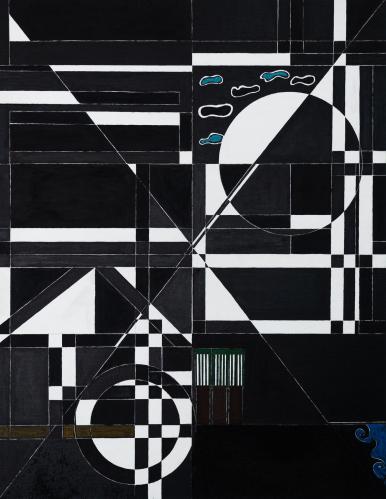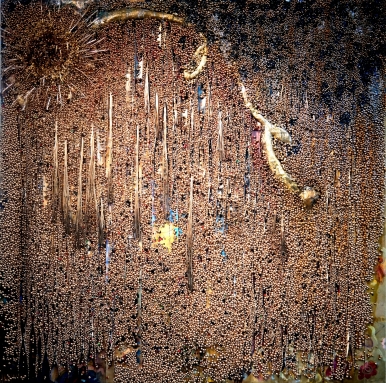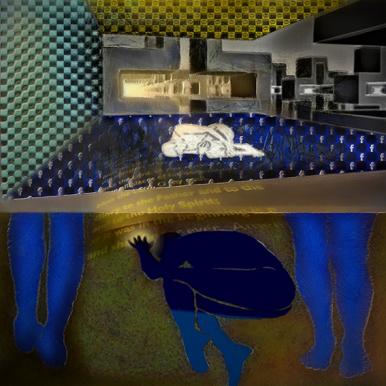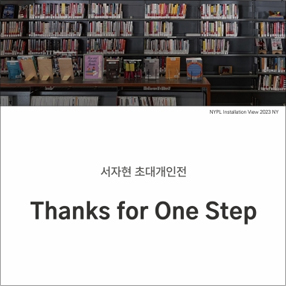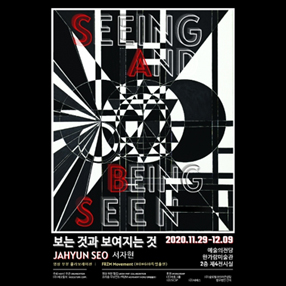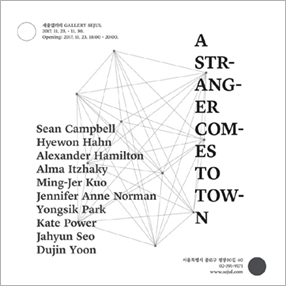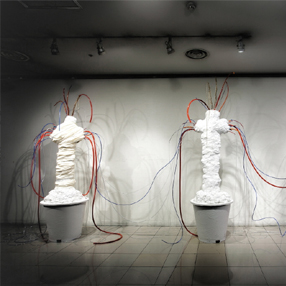
학력
2010년 홍익대학교 섬유미술 전공 박사
2003년 홍익대학교 섬유미술 박사 홍익대학교 직물디자인 석사
19094 프랑스 파리 네프빌 꽁뜨 고등 예술학교 창작텍스타일학과 졸업
레지던시
2016.07-2017.06 Nars Foundation Residency (NEW YORK)
2023. 03 Vermont Studio Center (VSC)
수상경력
2013년 제 21회 기독미술대전 특선
2018년 제 26 회 기독미술대전 특선
2004 Contemporary International Fiber Art (Shanghai)_From Lausanne to Beijing 3 입선
2001 청주 공예비엔날레 입선 (섬유부문_복고의 움직임+새로운∝ )
개인전
2023 19 회 개인전 뉴욕공공도서관(The New York Public Library), 뉴욕
2022 18 회 부스개인전 Kiaf PLUS, 세택(SETEC), 서울
2022 17 회 부스개인전, The Other Art Fair, 사치아트(Saatch Art), 뉴욕
2020 16회 개인전, 예술의 전당, 서울
2017 15회 개인전, Booth solo show( TovePove_art & design), 코엑스, 서울
2017 14회 개인전, 라마마갤러리아(La Mama Galleria), 뉴욕
2014 13회 개인전, 갤러리 K _‘Love n Relationship’, 서울
2014 12회 개인전, 지구촌갤러리(Global Mission Church), 분당/용인
2013 11회 개인전, 원촌갤러리(Wonchon Church), 서울
2012 10회 개인전, 빛갤러리(Vit Gallery), 서울
2007 9회 개인전 세오갤러리(Seo Gallery)_박사 청구전, 서울
2004 8회 부스 개인전, 예술의 전당, 서울
2004 7회 개인전, 제너바 아트페어(Geneva Art Fair in Switzerland –Korean Pavilion
2004 6회 개인전, 웨이브 아트페어(Wave Art Fair), 예술의 전당, 서울
2003 5회 개인전, 스웨덴 비엔날레(Sweden Biennale), Korean Pavilion, 스웨덴
2003 4회 개인전, (Kunststueck Gallery), 독일
2003 3회 개인전, 가나인사아트갤러리 (Ganainsa Art Center)_석사청구전, 서울
2003 2회 개인전, Wave Art Fair Invitational Exhibition (L.A. SUN Gallery), LA
1997 1회 개인전 (INSA Gallery), 서울
단체전
2023 The FarawayNearby, A.I.R Gallery, 뉴욕
2023 아트미션 제25주년 기념전 <지구 뜰 정원사의 은총일기>
2021 디스-코 디스-코 전(Dis-co Dis-co), 서울
2020 아트미션 202, 토포하우스갤러리(Topohouse gallery) , 서울
2019 와이드오픈 선셋파크 스프링 에디션(Wide Open Sunset Park Spring Edition),제이엔엠스튜디오 J & M Studio, 뉴욕
2019 한전아트센터( KEPCO ART CENTER), 서울
2019 아트미션2019, 이랜드스페이스(E-Land Space), 서울
2019 the endless love of you that came into the light, 사랑갤러리(Sarang Gallery), 서울
2018 홈테이블데코페어2018, 홍섬아디 아트앤디자인쇼(HFAD art & design Show), 코엑스, 서울
2018 Hope_Remember, 관훈갤러리(Kwanhoon Gallery), 서울
2018 Present, 사랑갤러리(Sarang Gallery), 서울
2018 가을 오픈스튜디오, 제이엔엠스튜디오 (J & M Studio), 뉴욕
2018 Thanks, 사랑갤러리(Sarang Gallery), 서울
2018 6th KCAF(Korea Christian Art Feast) 2018, 사랑의 교회, 서울
2018 봄 오픈스튜디오, 제이엔엠스튜디오 (J & M Studio), 뉴욕
2018 “IFA(International Art Festival)”, 2018 IAF Autumn in New York, 뉴욕
2018 천로역정(The Pilgrim’s Progress),케이엔피갤러리 (K & P Gallery), 뉴욕
2018 2018 Calendar show, 케이엔피갤러리 (K & P Gallery), 뉴욕
2017 A Stranger Comes to Town, 세줄갤러리(Sejul Gallery), 서울
2017 홈테이블데코페어2017, 홍섬아디 아트앤디자인쇼(HFAD art & design Show), 코엑스, 서울
2017 가을 오픈스튜디오2017, 제이엔엠스튜디오 (J & M Studio), 뉴욕
2016 Once There Was There Wasn’t, 나스 (NARS), 뉴욕
2015 Quindao Art Fair, Quindao international center, 중국
Korean Society of Basic Design & Art International Exhibition, 시애틀, 워싱턴
2014 오마주- 41 동시대 예술가들, 박수근 미술관( Park Soo Keun Museum), 강원도
측은지예-심, 한전아트센터(KEPCO ART CENTER), 서울
Think Love, Far East Broadcasting Corporation Gallery, 서울
2013 길, 선 갤러리(SUN Gallery), 서울
Serving with Small Works of Art and Love, Good Land Gallery of Sarang Community Church, 서울
Gifts Containing Love, Window Gallery of Hangaram Art Museum, 서울
2012 Hong Kong Contemporary Art Show, 홍콩
SOAF 아트페어, 서울
2011 Easter Thanksgiving 2011, Thornhill Church Centre, 영국
홍익섬유조형전, 홍익대학교 현대미술관, 서울
2007 Sense & Feeling, 마가미술관(Museum of Maga), 서울
2005 Good Land, 사랑의교회, 서울
2004 Korea New Wave Exhibition, 인사아트플라자갤러리( Insa Art Plaza Gallery ), 서울
로잔느 국제 섬유 비엔날레, 상해
2003 한국타피스트리협회전, 한전아트센터, 서울
L.A Biennale Independent Art, L.A. Sun Gallery, 로스엔젤레스
2002 The Absolute Art, 예가족갤러리(Ye-family Gallery), 서울
Hwa-woo Alumni exhibition,세정센터( Sejong Center), 서울
2001 미니어쳐 10회 그룹전 , 가나아트센터(Gana Art Space), 서울
청주국제공예비엔날레, 청주
2000 Hongik University Graduate School of Textile Art Exhibition, Seoul, 홍익대학교 현대미술관, 서울
1999 Hongik University Graduate School of Textile Art Exhibition, Seoul, 홍익대학교 현대미술관, 서울
1998 Artists of Atelier, 운현궁미술관, 서울
98 한국 현대미술 뉴욕 초대전, 뉴욕
The 3rd New York Invitational Exhibition, Cast Iron, 뉴욕
현대미술 초대전, 서울시립미술관, 서울
1993 Simolia, Porte de Versailles프랑스 파리
1992-94 Indigo, Parc d’Exposition프랑스 파리
1992 PRisunic, Musée de Montmartre프랑스 파리
아트페어
Kiaf Plus 2022
Kiaf Seoul 2023
The Other Art Fair 2022
Galleries Art Fair 2022, 2023
GENEVA PLLEXPO 2004
SWEDEN BIENNALE 2003
작품소장
연세대학교 통합신학대학원, 서울
사랑의교회, 서울
한강뮤지엄, 서울
네패스, 청안캠퍼스 및 충주 캠퍼스
진넥스, 서울
한국상담코칭진흥원, 서울
언론 인터뷰 & 기사
HUFFPOST, D. Dominick Lombard(May 2, 2017)Jahyun Seo: seeing and being seen
(https://www.huffpost.com/entry/jahyun-seo-seeing-and-being-seen_b_5908cd9ce4b084f59b49fd51)
Jahyun Seo's abstractions reflect the time in which we live in very curious ways. She sees us as we operate physically, emotionally and cognitively as compartmentalized beings defined by the relationships we cultivate, the jobs we have, the space we live in and the social presence we put forth. We tend to categorize, size up and prejudge yet we feel little comfort in the way we are perceived by others. And with social media the way it is today, ‘others’ can be an endless and painful line of complete strangers that have access to our every move, memory and emotion.
Seo’s latest series, seeing and being seen, has evolved over the years through a multitude of materials and a menagerie of means as she explores all the states of the human condition from the conscious to the unconscious, awake and asleep. Seo's art suggests we live lives that are more or less preset by many things that are out of our control. And since we are born into a station that is hard to move above and very easy to fall down from we must maintain a certain level of will and stability. We are also very much influenced by the more powerful media outlets that tempt us with things that are just out of our reach or far beyond our means. On the other hand, deep inside, we want to stand out, be seen as special or significant in our lives and in our contributions. However, many of us are most comfortable when we go unnoticed despite our inner most desire to be ‘famous’. Seo suggests in her earlier works in the series that we exist in a network symbolized by a patchwork of interwoven materials that are suspended like ritualistic objects of faith and culture. When installed, they appear as a fractured skyline that moves in and out of focus like birds through the mist of a morning lake. Only in this instance, the fog is a void and the lake is an empty bottomless space. From working with fiber, thread and paintings, she has since moved into the digital world creating virtual beings as a smoky presence in a black irregular cube. And like the floating islands in limitless voids, Seo finds her muse in the more recent works in the darkness where points of light and color create a sort of transmission of a soul. And it is in the static parameters and the darkness of infinite space that I am subtly reminded of the work of Francis Bacon who often revealed the essence of his subjects in confined and contorted forms. Overall, Seo defines the individual as a weightless trace of life that flickers and glows. she reveals us as highly susceptible to passing trends, the whims of an overbearing boss, changing life circumstances or volatile relationships. She suggests in her art that we are, after all, only a small cog in an endless stream of an ever expansive hierarchy that increasingly minimalizes and marginalizes us. From a distance, we are like stars in the sky linked by a common need for companionship – and yet, we are separated by the unexplainable or intangible. Seo also sees an inner being, an id flowing through a collective consciousness that gives us all the wear with all to survive, at least mentally. She finds patterns in chaos yet neither one is permanent because our very existence is fleeting, while the structure and form we live within can transform in a heart beat. If that happens, we must adapt to the changes, formulate new paths based on the discoveries we make and leave the devastation behind. So we press on, we make our way from one space, one grid, one cube to the next like a colony of insects – only with humans, we live in our thoughts differently than we do in our lives. We have imagination and will. We dream and we fantasize and we end up, most often, back where we started. What Seo hopes is we are a little more enlightened, hopefully a little wiser and perhaps a bit more willing to be different than our destiny would have us. And despite everything, all the limits and increasing differences between the haves and have-nots, there is hope. Where there is communication there lays the potential for true and fruitful engagement with others. When we see and are seen we exist in the moment as part of a wonderful, endless and multi-planed universe that we must make the most of, or find comfort with the level of satisfaction that is presented by the cubical at work, the overpriced apartment we live in, the quiet of the darkness pierced by the lights across the street and beyond that tell us we are part of a very large and growing group of similarly illuminated souls.
Jahyun Seo: A Process as Complex as Her Theme
by Jonathan Goodman
Jahyun Seo, a mid-career artist from Korea, received a doctorate from Honk-Ik University for an essay on multi-layered two-dimensional structure in contemporary art. This came after studies in the Department of Creative Textiles at the École Supériere d’Art at Neufville Conte in Paris. Additionally, Seo studied solid cutting in Paris and received a degree in color from Marseille University. Her extensive education demonstrates a resolve to gain the technical skill for the elaboration of a complex and very abstract theme, namely, the portrayal of seeing and being seen within the context of the media. This interest issues from an earlier one: the study of people and the relations between people, as influenced by their interaction with the media. Earlier, Seo’s materials consisted of fiber, thread, and paintings. Now her work is made with painting and computer design so that a technological process is introduced into her image-making. Her current installation, Seing and Being Seen (2022), evident where she works at the Nars Foundation, a non-profit space containing studios located in Sunset Park, Brooklyn, treats a subject matter close to being entirely abstract: images linked to the description and illustration of the media and its visual and also human consequences. The imagery of Seo’s room-size installation looks entirely abstract, with yellow, black, and brown panels connected by linear, often right-angled lines painted on the wall. At first glance, the installation might be seen as a diagram of electrical circuits, flat, square wafers are joined by lines. This imagery could easily be seen as a pictorial description of the kinds of connections made by people on electronic media. It is a remarkably good presentation, nonobjective in nature. The imagery addresses the distant, quite inhuman contact that results from the ties created by information originating not so much in relations among people, but, instead, among industrial webs whose connections are difficult to follow. Seo, who studied design extensively, has condensed a system of contacts into a simplified plan. While the overall encounter with Seo’s environment is that of a design or plan whose coordinates and meaning are hard to discuss, her viewers nonetheless understand that the work entails a preference for representing abstract processes. These processes imply relations between people that are determined electronically. The key to understanding Seo’s painterly installation depends on finding a balance— between representing a huge, impersonal system like that of the Internet and the emotional ties that might result from the operations of such an imposing structure. As exampled by Seo’s project, these ties may not be easy to read, but they reflect her complex insight into the way media influences human relations.
At the same time, for New York viewers, many of them accustomed to a formalist reading of art, might well see Seo’s work existing in close resemblance to certain developments within the New York School, namely hard-edge abstraction. For example, the paintings of Peter Halley, whose abstractions use forms close to Seo’s, come to mind. The comment is not meant as an attempt to characterize Seo’s art as existing within image-making in New York, yet it does seem as though her orientation takes a lot from modernism. Its formal existence continues in hidden and not so hidden ways, and the linear non-objective art we know well in New York might easily be used as a meaningful reference regarding the overall presence of Seo’s project. Perhaps the real challenge facing us in Seo’s art is her determination to render an abstract theme in abstract terms. The design we come across, inherent to her intention, intimates more than a mere pattern; it is the recognition that techniques resulting in knowledge may at first be abstract, but which align with an implied humanity—what we might call the consequences of the hand. It is true that the conjectures derived from this work must remain more or less tied to the inhuman, the technological, but at the same time, flesh-and-blood implications of the environment are present, even if they are somewhat distant from what we actually see. Not only is the overall design in alignment with a nonobjective pattern, the processes used to create the forms, regularly right-angled in expression, are much more mechanical than human. Seo begins by photographing an image, and then feeding the image into a computer, which then sends it into a machine capable of taking the image and rendering it three-dimensionally. Seo than paints the finished object, which is now as much a relief sculpture as it is a two-dimensional plane, in abstract fashion. The results are always abstract; a yellow panel may have black spheres dotting the field of the canvas in a purely non-objective manner. As I have indicated, straight black lines, often turning at right angles, exist both as imagery in their own right and as a means of joining the planar displays that are painted black, yellow and brown. One plane, occurring mostly in red, offers smaller pictures within it. The overall tenor of the installation presents pattern-oriented designs neutral but not necessarily not cold in nature. These patterns can be said to exist as the consequences of an impersonal design and, also, a working system for the creation of that design.The closest Western affiliation we can mention in art is that of hard-edge geometric painting. If the work is regularly, even relentlessly, oriented toward a non-human view, it is because the processes creating the works occur more or less completely without the use of hands. Likely the most pertinent formal question facing Seo is that if you are constructing a vision of abstract information by representing it in an abstract manner, how easily will your intentions, a human characteristic, be understood? It is not easy to develop insights into Seo’s motivations; her art evades any facile explanation of her focus. A severely reductive, close to minimalist manner pervades the installation, which seems more like an orientation toward impersonal arrangement rather than a human expression of interest. But that doesn’t matter in the presentation of Seo’s ideas, which are impartially abstract to begin with. The illustration of a system as large as the Internet will inevitably influence the way that illustration is carried out. Thus, abstract interests most often require abstract terms for elucidation. What is interesting about this installation is that its impersonal orientation does not diminish its anthropomorphic suggestiveness. How is this accomplished? By Seo’s willingness to tie her imagination to historical legacies of nonobjective art, formally speaking. The connection to an earlier cultural history provides the artist, and her audience, to see this project as part of a humanly considered effort, as much as an impersonal and mechanical one. This happens even if our initial experience of Seo’s environment is understood as more or less abstract. Still, the real question must be has to do with the content of the Seo’s environment. What is Seo trying to describe and present? The transfer of information, the loss of human relations in the face of electronic media, the ongoing visual strength of a geometric style? Maybe she takes an interest in all three concerns. Computer-generated or -embellished art is hardly new. We are more comfortable than ever in a world of impersonal imagery highlighted on a monitor’s screen. But we could also criticize such imagery as the antithesis of the hand, that is, as a rejection of human creativity. Yet art has always been known for its ability to internalize new technology without the visual consequences becoming cold or barren. In Seo’s case, the closeness of her work to historical work, such as early 20th century modern art, places her imagination in a continuum of artistic events that began in the early part of the previous century. This means that the abstract tradition, practiced for slightly more than a century, frames Seo’s current efforts within a historical context. Such a context inevitably brings the weight and gravitas of a historical legacy to contemporary efforts, whose effectiveness cannot be entirely independent of the past. In a way, Seo’s environment of two-dimensional imagery points the way both to the past and to the future—by beginning with a known understanding of non-objective art, which incorporates, at the same time, and however indirectly, the current shape of media relations and their effect on people. Yet the content of the installation remains opaque with regard to its reading of human interest. This is because the work gives no real indication of its focus and goal: the impartial portrayal of a body of organized information that only refers to itself. Abstract art, in general, is highly self-referential, being devoted to the elemental components of form without usually referring to anything external to the form. So we can only intuit the address of Seo’s work. Fine art of this sort usually eludes an extended analysis of content, relying instead on the strength of its compositional elements. If we were going to critique Seo’s composition, we would comment on its flatness, its lack of reference outside itself, its distance from any quick, readable analysis; thus, it would become a highly rational, if also modernist, wallpaper. But this is not truly the case. The emotional content, so hard to find in this piece, may well be there in the form of its historical associations, as well as our back knowledge of the artwork’s hidden origins: the presentation of the attachments among people that media both serves and damages. But it may be ture that the presentation of Seo’s art remains distant from the content that sustains it; as a result, we no longer know if the image truly demonstrates the content it is supposed to describe. Often in contemporary art, it is necessary to come up with an explanation clarifying materials difficult to understand. This is one of the major problems in fine art; the background of the artist’s motive becomes as important as that of the work itself, and often more so. Problems result. Why do we require so much explanation, of a literary nature, to elucidate a pictorial display? It makes no sense to constrain the innate freedom of visual effort by reducing abstract art to a series of intellectual assertions–even if such art can best be approached conceptually! On the other hand, today’s artists often make work of deliberate obscurity, requiring the delivery of knowledge not found in the art itself. The wall cards on museums, with their explanations, tend to become overly necessary; thus, writing that clarifies the art becomes a required but not alway successful accompaniment to the work, distancing us from the art itself. Abstraction in art likely requires a greater clarification, in the sense that it does not illustrate things that we can recognize. When an image turns to mostly hidden, internal laws, such as happens with Seo’s work, an explanation becomes needed. Not until we know the (concealed) motive of what we see, will we become aware of the artist’s intentions. Whether we can justify such obliqueness, hiding our interpretations, is for another discussion. So Seo’s undertaking references ideas meant to bridge the difference between ongoing references to an abstract system and a more sly, more covert reading in which of the abstraction that governs media–the presentation of information in a mostly electronic manner–maintains its impact on human relations. Seo’s terms are pretty much intact, although the innate humanity of the artist’s efforts, which must include the very human process of making art, as well as the humanist intimations of the connectedness among people, despite a technological landscape, makes it clear Seo’s intentions are hardly cold or entirely mechanical. Instead, her position, quite hidden if ultimately reachable, makes use of a conceptually derived position to communicate something very reasonable and hopefully accessible. Seo intends to join the human to an inhuman creative process, generated visually through the computer, that describes and appreciates the influence of electronic information. Time may well deepen the work, as it has often done with art and writing. But we must remember that the perceptible details of the environment she portrays cannot be seen as a close approximation of the visually known. Figurative attributes would lessen the unusual experience of Seo’s slightly concealed abstract goal: creating a bridge between what we wish to communicate and what we actually see.
It can be commented that the distance between the ideas implied in Seo’s undertaking and the processes that determine them is problematic: what we see does not reflect what we may know about the project. If Seo does not spell out her intentions, preferring to orchestrate the existence of her concepts behind the scenes, then something may well be lost. Ostensibly, the work is an abstract mural covering the wall of a room, no more. Yet, inevitably, in the long run, human concerns creep in. If this did not happen, the environment might be stifled by the limitations of its own existence. No art is entirely obscure, but if we push our intentions toward something easier to read, as well as recognizing the forms’ elucidation as something directed toward the human rather than the abstract, our interpretation will start to make more sense. This would occur no matter how abstract the overall composition and its construction might be. In new art, the joining of forces between the abstract and figurative is easily recognized; it is part of a a recognized spectrum determined by the appropriation of both styles and periods in time. Seo may not consciously join in such influences, but such art shows pluralism and appropriation, incorporated in a fashion that emphasizes just how difficult it is to merge an idea with its explanation. We need to determine the concept that would explain what Seo means. The gap between her own expressiveness and the conceptual, deeply non-objective means she uses to create does not easily result in a merger. They are separate issues demanding considerable effort to bring them together. Now that very abstract conceptual art is being made–art that sharply resists accessible interpretation–Seo’s work underscores the advantages and, to some small extent, the disadvantages of working so far from common understanding. Yet, given our need to advance art intellectually, Seo’s project is is a start in the right direction.
추가정보
학력 및 전시 경력:
서자현은 파리 네프빌 꽁뜨 고등 예술학교(Ecole Superieure D’art Neufville Conte)에서 창작텍스타일학과를 졸업한 후 홍익대학교에서 ‘현대미술의 다층적평면구조에 대한 이론적 연구’로 미술학 박사학위를 받았다. ‘Seeing and Being Seen’ 주제로 The New York Public Library(뉴욕, 2023)외, 예술의전당(서울, 2020), La Mama Galleria(뉴욕, 2017)에서 19회의 개인전을 가졌고 2024, 2월 뉴욕 A.I.R Gallery의 Thefarawaynearby의 프로젝트 전시외 총 200회 이상의 단체전에 참여하였다. 2023.03 미국 버몬트주의 ‘VSC(Vermont Studio Center)’와 2016.07-2017.07 뉴욕의 ‘Nars Foundation’에서 아티스트 레지던시 프로그램을 참여 후 뉴욕, Pen and Blush Gallery와 브루클린의 J&M Studio에서 활동 중이다.

